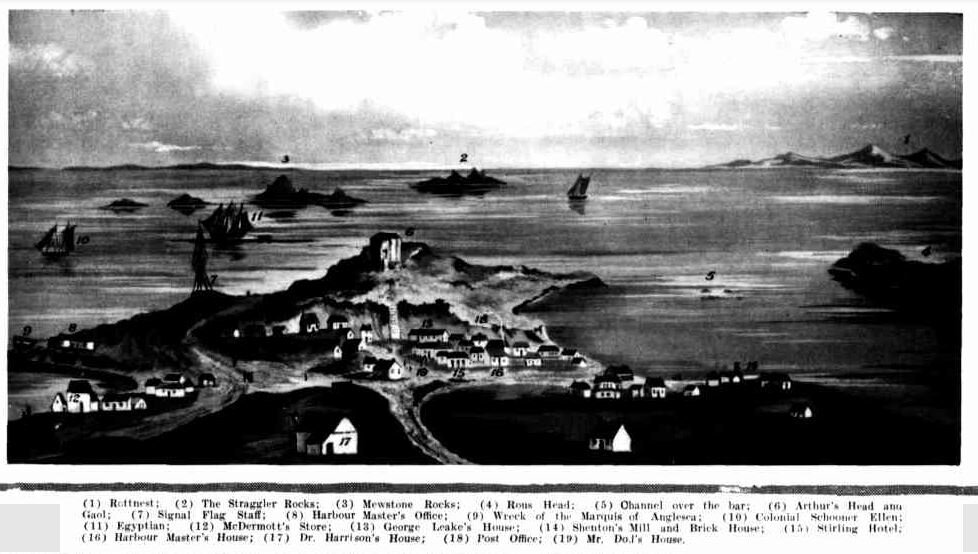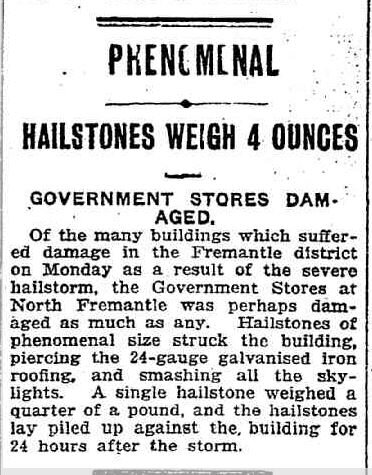COMMISSARIAT BUILDINGS, CUSTOMS HOUSE, currently the WA SHIPWRECKS MUSEUM
Architecture: Built in 1853, the Commissariat Buildings are a substantial utilitarian building of limestone construction in the Victorian Georgian and the Victorian Regency styles. Australia. The design, scale and siting of the group of Commissariat Buildings combine to define the south west boundary of the West End of Fremantle.
Originally built to store the food, clothing and building supplies of the Swan River colony, these buildings are among the first Western Australian sites built using convict labour.
See Sketch of 1832 Fremantle showing(on right): (1)Rottnest (2)The Straggler Rocks (3)Mewstone Rocks (4)Rous Head (5)Channel over the bar (0)Arthur's Head and Gaol (7) Signal Flag Staff (8)Harbour Master's Office (9) Wreck of the Marquis of Anglesea (10) Colonial Schooner- Ellen (11)Egyptian (12) McDermott's Store (13) George Leake's House (14) Shenton's Mill and Brick House (15) Stirling Hotel (16) Harbour Master's House (17) Dr. Harrison's House (18) Post Office (19) Mr. Dod's House.
With the creation of the Commonwealth Historic Shipwrecks Act 1976, the Western Australian Museum became the delegated authority for management of Commonwealth historic shipwrecks and relics in Western Australia.
As a result, the State Government funded the conversion of the heritage Commissariat Buildings into what is now known as the WA Shipwrecks Museum. It opened to the public in 1979.
HISTORY
1897 Bandicooting! William Ruddy steals 10 lbs of potatoes from Customs House and gets 1-month imprisonment (reference)
1898 Now that the river has been dredged and steamers can bring their cargoes of ever-restless humanity right up to the wharf, the old system of discharging them at the pier has been done away with… The procedure at the pier was, perhaps, one of the most incomparable and incongruous scenes imaginable. Passengers' luggage was thrown out on the wharf. Those who could afford be rooked by the carting spielers (who hung around the vessels like crows on a dead carcase) had their luggage looked after, but those who had come to find the El Dorado of the West were subjected to a terrible shock when told it would cost them 5s. to get their traps up the pier, for a start. They had to hump their luggage about a mile and then have the satisfaction of seeing a Customs officer pull everything upside down without any reason for so doing… the clothing and paraphernalia of the deluded victims to W.A. snares is roughly and indecently handled by those august, pompous porcupines called Customs officers. It is quite a common occurrence for ladies, who are only, as a rule, too glad to get off the ship quickly and join their friends, to have to stand amongst these inquisitive, vulgar crowds of gazers while their boxes are opened and their various articles of underclothing and other things peculiar to the feminine wardrobe (and which in good society are not even mentioned) are pulled cut and examined with the low-bred and disgusting insinuendo adopted by these Customs officials.
Sunday Chronicle 14 August 1897, p 1 -The Fremantle Custom House Vagaries’’ (reference)
1898 A preliminary inquiry was held at the Customs House, Fremantle, to investigate attending the wreck of the Norwegian barque August Tellefsen, attended by Mr Clayton T Mason, Collector of Customs and Mr J Lilly JP … (reference)
1902 After sixteen years service as Chief Harbour master of Fremantle, Captain Russell is leaving for England this afternoon by the G.M.S. Konigin Luise, on six months leave, at the expiration of which period he will retire from the service. Captain C. J. Irvine, who has been appointed Acting-Chief Harbour master, presided over a farewell function. (reference)
1905 The old Customs House in Cliff-street, Fremantle, has been vacated, and the new premises in the A.U.S.N. Co.'s buildings, in Phillimore-street, opposite the railway station, have been opened for business. (reference)
1906 Recruits for the Navy- Instructions have been received by the Commander of H.M.S. Challenger from Sydney to enrol ten seamen. Applicants will have to be at the Harbour Master's office, Fremantle. at 9 o'clock this morning, as the cruiser sails on Thursday. (reference)
1919 PHENOMENAL HAILSTONES. Of the many buildings which suffered damage in the Fremantle district as a result of the severe hailstorm, the Government Stores at North Fremantle was perhaps damaged as much as any. Hailstones of phenomenal size struck the building, piercing the 24-gauge galvanised iron roofing, and smashing all the sky lights. A single hailstone weighed a quarter of a pound, and the hailstones lay piled up against the building for 24 hours after the storm. (reference)
1920 The Chief Inspector of Fisheries (Mr P. Aldrich) referring to a shark seen near the Fremantle jetty, by Mr. L. Pascoe: “…was not a tiger shark, but a wobbegong”said Mr. Aldrich “The wobbegong, or carpet snake, is a hideous-mouthed creature, and attains a large size, individuals of 10 feet being not uncommon.” (reference)
1923 The premier and parliamentary party photographed at the Government Stores, Fremantle, inspecting the first bales of cotton (totaling 6,672 lb), ready for shipment to Liverpool. (reference)
1924 WIRE NETTING - Government Stores Overcrowded - Yesterday morning the Minister for Lands and Migration (Mr. W. C. Angwin) said that the Government Stores at Fremantle were becoming full of wire netting being landed under the Commonwealth grant. The delay of supply, he says, is at present due to the farmers themselves. (reference)
1925 Handling of Explosives. It was stated that certain regulations in connection with the handling of inflammable cargo and explosives were not being carried out by some shipping companies. It was not sufficient that a vessel should show a red flag during the day and a red light at night. There was frequently enough explosive cargo on the wharf to blow it up, and it was necessary that precautions should be taken…About the middle of last year the City of Singapore was 'blown up at Adelaide, and all that was found of a fireman who was on the vessel was 13 buttons and his top teeth…” (reference)
1926 Captain Harris, late Harbour Master at Albany, has been appointed Chief Harbour Master. Captain Winzar is retiring on the 4th of March after 30 years service. Captain Harris is a native born West Australian, who in his young days roughed it with the best and worked his way up from the lowest rung of the ship's ladder. (reference)
1931 News has been received here of the death of Captain John Wellstead Kent Harris, Chief Harbour Master for Western Australia, at Fremantle early on Sunday morning. Captain Harris, who was only a middle-aged man, had been in ill-health for some time, but had not relinquished his duties. He is stated to have suffered a sudden seizure on Saturday, and his death occurred the following day. (reference)
1933 Photo of an old Lock. This relic from Commissariat Building, used during the days of convict transportation, was given into the care of the Historical Society of WA…Given to Mr Sweetman, an officer of the Customs Department when the locks were changed by Mr Clayton Mason. (reference)
1936 During last night Harbor and Light Department's workshops, Marine Terrace, Fremantle, were broken into and paint, tools, nails and rivets, total value £14/5/ stolen (reference)
1938 The death occurred yesterday, after a short illness, of Captain Harold Stephen Nicholas, harbour-master and berthing master at Fremantle. He was in his fifty-sixth year. He had been associated with Fremantle Harbour and with the work of the Fremantle Harbour Trust for 25 years. (reference)
1940 NEW HARBOUR-MASTER. Captain W. R. Clack Retires. After 24 years in the pilot service of the Fremantle Harbour Trust, Captain W. R. Clack, who followed the late Captain H. S. Nicholas, as harbour-master at Fremantle two years ago, will end his active career on Sunday, when he will commence six months' leave prior to retirement. His successor will be Captain H. K. Saunders, who joined the trust as a pilot in September, 1918. (reference)
OCCUPANTS
1897 - 1905 Customs Department, Railway Goods Depot, Harbour Master's Office
1906 - 1942 Harbour Master's Office, Harbour & Light Department Inspector of Fisheries
1906 - 1949 Government Stores Department
1942 - 1949 J. & W. Knell, wool merchants






